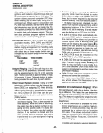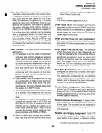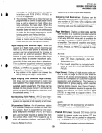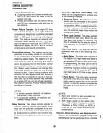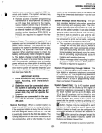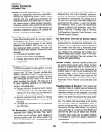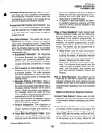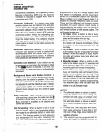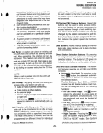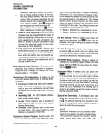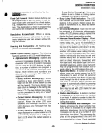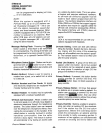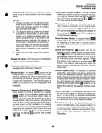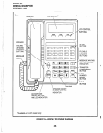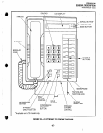
,*
!
j:
STRATA OK
GENERAL DESCRIPTION
DECEMBER 1990 ’
successfully completes, the originating station
.%eunds a distinctive ABR tone. No optional
hardware is required to support ABR. ABR is
compatible with LCR.
Automatic Callback*: If a station user dials
another station over an intercom line and gets
a busy signal, the user can hang up and have
automatic callback (ACB) redial the number.
When the busy station is freed, ACB calls the
originating station. When the originating sta-
tion user answers the ACB recall, the system
rings the called station. The callback request
will stay active indefinitely until either the
called station is freed, or the caller cancels the
ACB request.
programmed to ring at a single station (and
that station is forwarded). All CO lines trans-
ferred to a forwarded station.will forward,
When a station is in a call forward mode, it is
allowed to originate telephone calls as usual.
There are five different call forward modes
available for each station. Each mode is
set/canceled by the station user via individual
call forward buttons or dial access codes. The
call forward modes are:
l
All Calls: When a station is idle or busy,
all calls to the station will forward immedi-
ately and the station will not ring.
l
Busy: When a station is busy, all calls to
the station will forward immediately. When
the station is idle, incoming calls will ring
normally.
Automatic Hold/Park Recall*: A CO line or
l
No Answer: When a station is idle, calls
intercom call placed on-hold or parked will
to the station ring for 12 seconds2 and then
automatically recall the station after a previ-
ously programmed time period. A different
forward. When the station is busy, incom-
time period can be selected for each station.
ing calls will receive busy tone when call-
ing the station.
Automatic Line Selection: Each station can be
programmed so that when the handset is lifted
or the m button is pressed, a CO line, CO
line group, or intercom line is automatically
accessed.
Background Music with Station Control: A
station user may control background music
playing over the station’s speaker. The music
may be switched on or off and the volume may
be adjusted to suit the individual user. A desig-
nated station (200) can control (on/off) back-
ground music played over the external page
speakers.
l
Busy/No Answer: When a station is idle,
calls to the station ring for 12 seconds and
then forward. When the station is busy,
incoming calls will forward immediately.
l
Fixed: When the station is either idle or
busy, all incoming calls will forward imme-
diately and the station will not ring. Fixed
call forward is different from the other call
forward modes in that the destination sta-
tion is set once in system programming,
not selected each time the user sets the
station in a call forward mode.
Busy Override*: Upon calling a busy station
and receiving a busy tone, the caller can dial 1
to sound a tone burst to the called station.
Busy Override is available to all stations and
cannot be blocked.
NOTES:
1. The alternate station or device is select-
ed by the station user when setting call
forward (all calls, busy, no answer, and
busy/no answer). With fixed call forward,
the alternate station or device is select-
ed in system programming for each sta-
tion.
Call Forwarding: When a station is set in a call
forward mode, calls to the forwarded station
are routed to an alternate station or voice mail
device. This feature applies to both intercom
and designated CO line calls. Incoming CO
line calls will forward only if the CO lines are
2. If voice first, one ring tone will occur,
then voice announce. If tone first or CO
line call, three rings occur before for-
warding activates.
3. The system’can 66 programmed to
allow the DSS (or DDSS) console or
*Available using standard or electronic telephones.
-4o-



